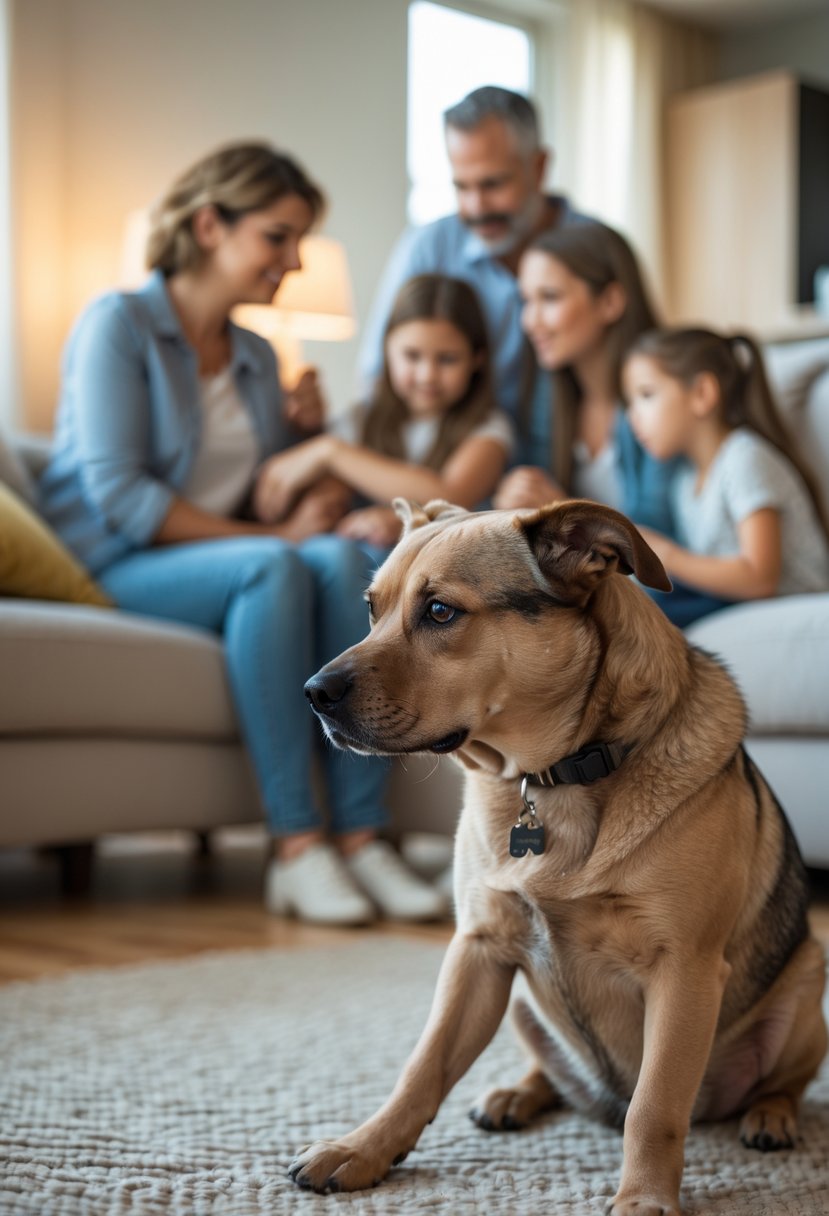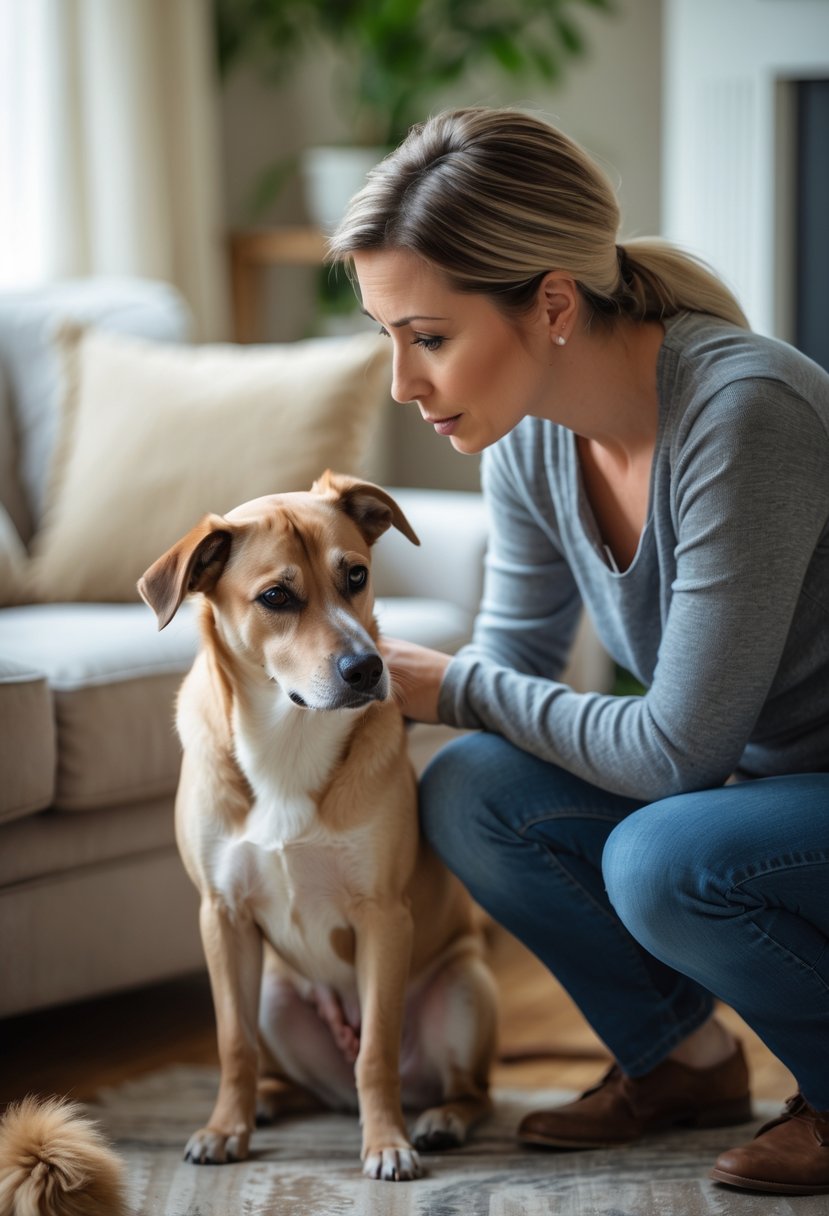Many dog owners want their pets to be happy but may miss important warning signs when something is wrong. Dogs often show their feelings in ways that are easy to overlook or misunderstand.
Knowing the warning signs that a dog is unhappy can help owners respond quickly and improve their pet’s well-being. Learning what these signs look like makes it easier for owners to support their dogs and keep them healthy.
1) Sudden loss of interest in play or walks

A happy dog looks forward to playtime and daily walks. If a dog suddenly stops showing interest in these activities, it can be a warning sign.
This change may indicate that the dog feels unwell, stressed, or sad. Owners should watch for this sign and observe closely.
2) Excessive licking or chewing of paws
When a dog licks or chews its paws a lot, it can be a sign of discomfort or stress. This behavior is not just normal grooming if it happens often or leads to redness.
Common causes include allergies, irritation, pain, or anxiety. It may mean something is bothering them, and a vet should check it.
3) Avoidance of eye contact

Dogs may avoid eye contact when they feel anxious, uncomfortable, or unsure. This is a common way for dogs to show that they are not at ease.
Avoiding eye contact can also signal submission, fear, or stress. Owners should watch for this behavior as it may mean their dog is unhappy.
4) Increased yawning or heavy panting without cause

A dog that yawns more often, even when not tired, may be stressed or uncomfortable. Heavy panting when there is no heat or exercise can be a warning sign, too. Owners should pay attention if these changes happen without an obvious reason, as they may show the dog is unhappy or uneasy.
5) Whining or excessive vocalization

Dogs may whine or make too much noise when they are unhappy or want something. Whining can be a sign of stress, discomfort, or a need for attention.
If a dog starts whining more than usual, pay attention to the situation and look for other changes in behavior.
6) Changes in appetite or eating habits

A dog that suddenly eats less or skips meals may be feeling unhappy or stressed. Some dogs might show the opposite, eating more than usual for comfort.
Changes like these are signs that something could be wrong. Owners should pay attention if their dog’s eating habits change without a clear reason.
7) Withdrawing or hiding from family members

Dogs who hide or spend more time alone could be feeling anxious or sad. Some may avoid people by going under beds or staying in quiet corners.
Withdrawal can also happen if a dog is not feeling well or is in pain. This behavior often signals that something is wrong.
Understanding Your Dog’s Emotional Well-Being

Dogs have their own ways of showing how they feel. Sometimes they are clear, but often their signs are missed, leading to misunderstandings and stress for both the pet and the owner.
How Dogs Communicate Discomfort
Dogs use body language, vocal sounds, and changes in behavior to show when something is wrong. For example, a dog may tuck its tail, flatten its ears, or avoid eye contact when feeling anxious or upset. Other signs include yawning when not tired, sudden licking of lips, or pacing back and forth.
Common signs of discomfort include:
- Hiding under furniture
- Whining, whimpering, or growling
- Loss of interest in toys or play
- Changes in eating or sleeping patterns
Dogs might also shake, pant, or try to leave the room. These reactions can happen suddenly, even if their environment seems calm to humans. Observing these clues can help owners notice when their dog needs help or reassurance.
Common Misinterpretations of Canine Behavior
Some dog behaviors get mistaken for stubbornness or bad manners. A common error is thinking a dog is ignoring commands when it could actually be nervous or overwhelmed. Slow movement or hesitation is sometimes blamed on laziness, when it may be caused by fear or pain.
Frequent misinterpretations include:
| Behavior | What Owners Think | Possible Emotional Cause |
|---|---|---|
| Barking | Attention-seeking | Anxiety or discomfort |
| Hiding | Being antisocial | Stress or fear |
| Not eating | Picky eater | Unhappiness or illness |
Sometimes, owners punish these behaviors, which can make problems worse. Recognizing the difference between a behavior problem and an emotional need helps create a safer, happier home for the dog. Reading cues correctly lets owners respond in caring and effective ways.
What To Do If You Suspect Your Dog Is Unhappy

Caring for a dog’s mental and emotional health is just as crucial as meeting their physical needs. Owners can take practical steps at home and should know when to reach out for professional help.
Steps To Improve Your Dog’s Quality Of Life
Start by reviewing the dog’s daily routine. Dogs need a consistent schedule, regular exercise, and enough playtime. Adding extra walks or new toys can enrich their environment and boost their mood.
Spend more quality time with your dog. Short training sessions, gentle grooming, or simply sitting together can strengthen your bond. Many dogs respond well to positive reinforcement, like treats or praise, when they show interest or improvement.
Social needs are important. Some dogs may enjoy spending time with other friendly dogs or meeting new people. If your dog seems bored or lonely, try organizing short playdates in a calm setting.
Create a comfortable resting area. A cozy bed away from noise and household traffic allows your dog to relax. Make sure they have easy access to fresh water and are fed a nutritious diet each day.
Common signs your dog is feeling happier:
| Sign | Description |
|---|---|
| Increased playfulness | More interest in toys or games |
| Better appetite | Returns to eating normal amounts |
| Relaxed behavior | Calm body language, restful sleep |
When To Consult a Veterinarian or Behaviorist
If your dog’s mood does not improve after making some changes, it may be time to get professional advice. Some medical problems, like pain, arthritis, or digestive issues, can cause changes in behavior that look like unhappiness.
Warning signs that need a vet visit include rapid weight loss, limping, sudden aggression, or changes in bathroom habits. A veterinarian can examine for issues that are not obvious and may suggest blood tests or other checks.
For ongoing or severe behavior issues, such as fear, anxiety, or aggression, a certified canine behaviorist may help. They can create a custom training or support plan based on your dog’s needs.
Quick action can help prevent problems from getting worse. Early intervention is best for your dog’s health and behavior.
Frequently Asked Questions

Dogs show unhappiness or stress in both their actions and their physical cues. Sudden changes in play, appetite, or energy, along with new habits like hiding or excessive licking, can hint at emotional issues.
What are the common indicators that my dog might be stressed?
Common signs of stress include restlessness, pacing, and whining. A dog might also yawn or pant heavily even when it is not hot or tired. Other stress signals include shaking, pinned-back ears, or avoiding certain rooms or people.
What behavioral signs suggest a dog is not content?
A dog that stops playing, loses interest in walks, or changes its sleeping patterns could be feeling unhappy. Some dogs become withdrawn, while others start to vocalize more through barking or whining. Changes in appetite or bathroom habits may also point to discontent.
How can you tell if a new environment is affecting your dog’s mood?
Dogs might hide, cling to their owners, or explore less in a new place. Increased yawning, heavy panting, or loss of interest in toys can also mean the environment is stressful. Refusing food or walking away from usual activities are additional red flags.
What actions might a dog display if it feels unhappy or uneasy?
Chewing or licking paws more than usual is a sign of unease. A dog may avoid eye contact, become less social, or seek isolation. Some dogs display repetitive behaviors, such as circling or excessive self-grooming, when uneasy.
Why might a dog exhibit changes in behavior, such as hiding or acting out of character?
Changes like hiding, aggression, or extra clinginess can be caused by emotional distress, pain, or fear. New environments, loud noises, or changes in family routines can trigger such behavior shifts. It’s important to look for patterns to find the cause.
How can you interpret your dog’s body language to assess its well-being?
Stiff posture, tail tucked between the legs, or lowered body position often show discomfort. Avoiding eye contact or turning their head away can mean a dog feels threatened or sad. Relaxed ears, soft eyes, and an open mouth usually suggest the dog feels safe and content.
